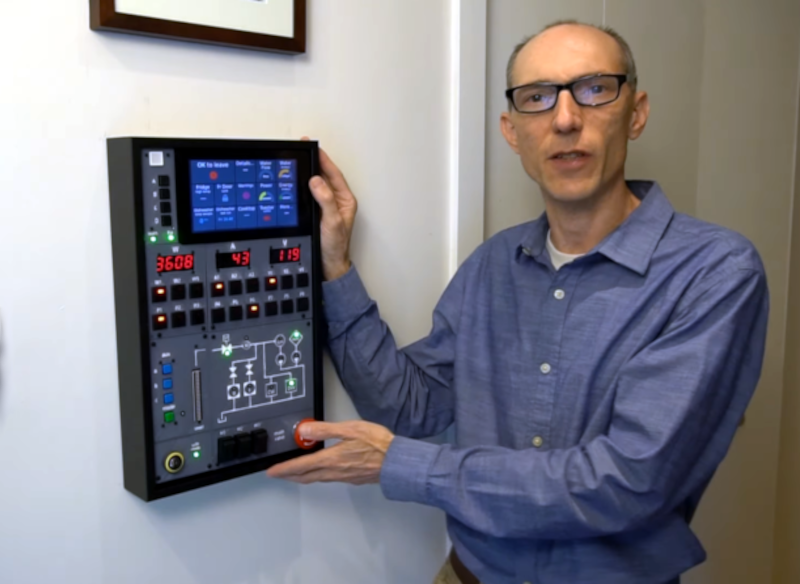Modern tech is great, but we have to admit that we sometimes miss when electronic things looked complicated. A modern computer looks dull compared to, say, an IBM 360. Control rooms now look no different than a stock trading room, instead of being full of indicators, knobs, and buzzers. [BorisDigital] must have some of those same feelings. He built a very cool control panel for his Home Assistant setup. He based it somewhat on a jet cockpit and a little on a nuclear plant control room, and the result, as you can see in the video below, is great.
This is less of a how-to video and more of an inspirational one. After all, you won’t have the same setup, but there are many details about how it was constructed with a Raspberry Pi, 3D printing, and control of the Home Assistant via web services.
You might point out that you could put everything on a computer screen, but what fun is that? There is a touchscreen, so you do have some options. Normally, the panel hangs on the wall, but you can snap feet on to rest the panel on a desk or table.
The panel has about 50 I/O devices, so a GPIO expander — actually several of them — was necessary. To make a nice-looking label, he fills in 3D-printed inset text with spackle. It isn’t perfect, but it looks good enough.
















Oh it’s beautiful. Cockpit and nuclear power plant as home decor. I would have said CNC machining center. Makes Alexa look like a Disney princess, snd that’s not a compliment.
I’m glad he remembered the big red button.
Big red button… Great idea, not really needed for water if the system already monitors for problems. I would use it for kid emergency… Turns on flashing lights, alarm and calls your cel phone and time out to call 911 operator. I like the overall idea. Way too nerdy, lol
I think it’s absolutely gorgeous (not really comaptible with my home decor though) but what bothers me about it is the screen reaction time. With a proper clicky-clackey button, that screen should update instantaneously!
Nonetheless, I love how nerdy and industrial it looks.
Nice work! But what I really want is a big color non-glossy touch-screen running a Star Trek LCARS themed Home Automation (HA) display. That would not only be pretty easy to make, it would be really functional. The problem is some greedy MBA or Trial Lawyer at CBS Television Studios would probably sue my pants off in a heartbeat.[1] So much for Fan Appreciation :-(
1. LCARS – Legal
https://en.wikipedia.org/wiki/LCARS#Legal
How would a lawyer working for CBS know what you have in your home? How would they quantify the economic harm that your device causes CBS? Why would anyone bother even if they somehow became aware of it?
Back when I was designing and building 3D printers I used to see stuff like this all the time. There was a patent on heating the chamber and a lot of guys were saying things like “Gee, I’d like to have a heated chamber for my printer, but Stratasys owns the patent and I don’t want to get sued”. If you DIY things, there’s a good chance you’ll infringe on someone’s patent or copyright. I don’t know any DIYers who do searches before they build things- if they did they’d spend all their time and money searching patents and never make anything – unless they are searching for ideas for their own DIY projects (I have done this many times).
I once made an LCARS design and got sued by Sony because I was sitting at home humming a Beyoncé tune and the neighbours heard, and so I’m writing this from jail of course.
In fact part of the reasoning for the patent system in the first place was that DIYers would be able to use a patent to make the object in question for themselves. As long as you aren’t profiting off of a patented item, ie you just made it for yourself at home, there is nothing to sue you about.
He´s Trevor Reznik. Or maybe Ivan.
Love the style of the project and presentation !
I wonder what would be the implication, hw and Software design wise, of having the LEDs and buttons red and controlled by a micro controller.
For the front panel I would have opted for some aluminium dibon sheets style material (plastic sandwiched into thin aluminium sheets) because I think the available colors or metal finish look neat and also I’m used to work with these but I guess that kind of choice depends on what’s already sitting on your work bench !
Dibond panels are a great resource for making front panels.
Because they are used in advertising, it is cheap and easy to have a panel printed with your design and cut to shape(including holes).
I had the front panel for my power supply printed. The quality of the finish is incredible, and looks like a commercial product.
I’m a sucker for projects like this. I would go full analog, though – a large series of those vertical panel meters at 0:36. In some of those meters a wheel inside rotates and the marker line (needle) is stationary, so you can color code sections of the wheel to reflect the danger level you want to convey.
Some day I’ll get back to that project.
Open the refrigerator door, HAL
That kind of request has cropped up before, and it has always been due to human error.